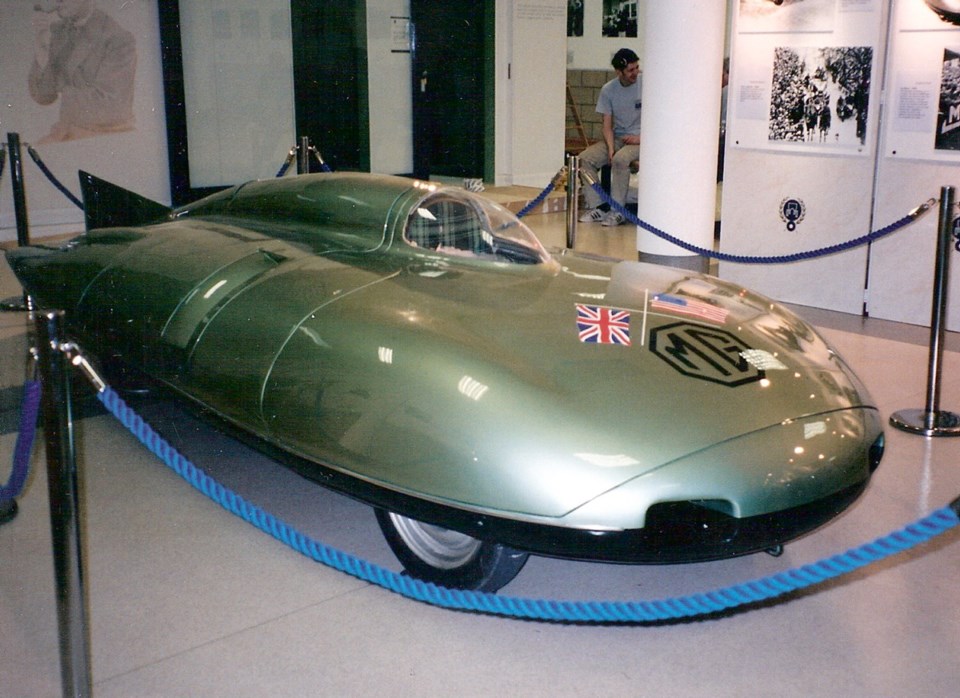British MG sports cars gained popularity in North America following the Second World War and were enthusiastically raced, even though they were not particularly fast in stock form. The square-rigged TD could barely reach 130 km/h, and it took until 1957 for an MGA coupe to top 160 km/h (100 mph). Triumphs and Austin-Healeys had reached the “ton” years earlier.
But inside those modest sports cars lurked great potential, as demonstrated in 1951 by legendary English MG racer Lt.-Col. A.T. (Goldie) Gardner. He took a special aerodynamic MG streamliner, designated EX-135, with a supercharged 1,250-cc TD engine to Utah’s Bonneville Salt Flats and posted six international and 10 American speed records, including averaging 224 km/h for an hour.
Bonneville was chosen because this part of the Great Salt Lake Desert, 160 km west of Salt Lake City, Utah, is large, smooth and level and the salt is easy on tires. It is the shrine of land speed records.
In 1952, Gardner returned to Bonneville with the EX-135 and hit 325 km/h, setting 21 speed records in Class F (1.1 to 1.5 litres displacement).
While Gardner had soundly demonstrated MG’s high speed ability in 1951 and 1952, engineers at MG’s parent British Motor Corp. knew there was more.
MG returned to Utah’s high desert in 1957 to pursue the class F record with a new, fully enclosed, teardrop-shaped MG, the EX-181, hoping to reach 400 km/h (250 mph).
The EX-181 was very small at only 972 millimetres high, 4,610 mm long and 1,632 mm wide with a 2,438-mm wheelbase. The front track was 1,067 mm and rear a much narrower 781 mm, to fit the wheels within the tapered aluminum body.
A central rear fin aided high-speed stability, and the coefficient of aerodynamic drag was said to be an extraordinary 0.12 (modern passenger cars are 0.25 to 0.30).
The coil-spring front suspension and rack-and-pinion steering were from the MGA, with the rear axle replaced by a de Dion type on quarter elliptic springs. Final drive ratio was 1.94:1. Braking was a single, rear axle-mounted disc requiring up to 5.0 km to stop from high speed. Rolling resistance was reduced by smooth 450x15 tires inflated to 60 pounds per square inch.
The BMC B series, 1.5-litre four-cylinder engine had twin overhead camshafts replacing the pushrods. A gear-driven Shorrock vane-type supercharger breathed through two SU carburetors and pumped air into the cylinders at boost reaching 32 psi at 7,000 engine rpm, giving 290 horsepower.
The engine was mounted amidships in the tubular steel frame. Unlike the EX-135 in which Gardner sat behind the engine, EX-181’s semi-reclining driver was in the very front. Engine cooling was by small aircraft type radiators on each side just behind the driver.
Gardner was unavailable due to ill health, so BMC hired outstanding drivers. Stirling Moss, one of Britain’s best ever, was the main driver, with the alternate being American Phil Hill, who would win the World Driving Championship in 1961.
Hill took the EX-181 for a test run on Sunday, Aug. 18, 1957, and although it was the first time at speed, he found it satisfactory except for gasoline fumes in the cabin. Moss arrived the following Tuesday for a Wednesday run but rain washed it out.
Thursday’s weather was better, but problems delayed the run until 5 p.m. Although it was late in the day, Moss insisted on going. It took a couple of tries due to the loss of third gear, but before the sun had set he covered a measured mile at an astounding 395 km/h (245.11 mph), close to the target. Even though he was an experienced Grand Prix racer, it was the fastest Moss had ever driven.
It was a tremendous speed for a 1.5-litre car, and provided wonderful publicity for MG, which trailed the competition in performance. MG addressed the performance deficit with the 1959 MG Twin Cam model, but it came with problems and was short-lived.
The MGB arrived as a 1963 model and was carried on until 1980 by British Leyland Corp., as the company was now called. The MG name would continue in sports sedans, and then in the early 1990s in the MG RV8 and MGF sports cars that were not exported to North America.
MG Rover (yet another new name) returned to the salt in 2003 with an MG station wagon (!) and went 362 km/h (225 mph), claiming to be the world’s fastest station wagon. But those 1951, ’52 and ’57 records were still MG’s finest high-speed hours.



